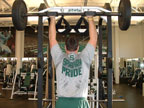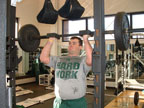Exercises, Equipment Modes, and Rep Duration
The training landscape is in a state of continual flux, and the ongoing changes, updates, and emergence of proposed cutting-edge devices and techniques makes for interesting and thought-provoking debates among practitioners.
The inquiries I receive the most deal with lifting movements, equipment modes, and rep duration.
Two recent questions are symbolic of the ones I receive on a regular basis:What strength training movements and equipment modes would you classify as being the best, or most important, for athletics?
This has been a topic of much discussion over the years, with as many different answers as those giving them. Those with an affinity for the Olympic style lifts and/or their close relatives will adamantly profess their virtues.
Power lifting enthusiasts will expound their firm convictions on the “Big 3”: the bench press, squat, and dead lift.
Others will lean more toward the newer wave of “functional” training activities as being more specific to athletic movements.
And, of course, there is the seemingly endless diatribe regarding the superiority of either free weights or machines.
Coaches eventually develop their own unique training approaches and make personal determinations on lifting priorities. If they have covered all of the bases and constructed a strong rationale for what has been implemented, it is difficult for anyone to disagree with them.
However, it must be stated loud and clear that not only is the jury still out on some of these issues, they are all scratching their heads and rubbing their eyes trying to separate fact from fiction.
With all due respect given to the current multitude of training methodologies, here are some suggestions and perspectives from our corner.
First off, you should place a heavy emphasis on multi-joint movements; i.e., those lifts that engage muscle compartments crossing more than one joint. You will find a wealth of choices to fit the bill for both the upper and lower body segments. How they are performed and what modes are used in their execution will always be a matter of personal preference.
That is not to say that single-joint movements should be totally eliminated, as they have their place in targeting weak links and as adjuncts in special needs situations. The brunt of your work, though, should be accentuated with multi-joint movements.
All coaches must realize that it is their duty and ultimate responsibility to train their athletes with the utmost care and diligence. At the very least, attention must be paid to every safety aspect of the chosen lifting protocol with the inclusion of a comprehensive risk/benefit analysis.
We don’t subscribe to any specific lift or composite of lifts as being “superior” in athletic development. If you read comparative research studies objectively (Carpinelli, et al., 2004), you will find that while all lifting movements serve a host of purposes, none of them can stake an unequivocal claim to being the best. It is my personal opinion that there are far too many individual differences, objectives, parameters, and special needs situations to allow you to be handcuffed to a narrow focused exercise menu.
The same holds true for equipment. Think about it: If any one type of equipment had been determined by consensus to be the end all, no other type of equipment would be worthy of existence. The reality is that we need a well-stocked toolbox of choices and a profusion of variety to meet the goals and needs of a diverse athletic population.

Should strength-training reps be performed at fast, slow, or moderate speeds (i.e., is there an optimal rep duration)?
A host of factors and determinants will play into the answer here.
If you are an Olympic lifting aficionado, then the mere nature and successful execution of the lifts will dictate shorter rep durations (i.e., faster speed of movement).
In other lifting movements, the weight load becomes a primary indice, in that lighter weights are more conducive to shorter rep durations, while heavier weights usually require longer rep durations (i.e., controlled speed of movement).
Some practitioners teach the use of short rep durations in all of their lifting prescriptions, others recommend the use of heavier weights with concurrent longer rep durations, while another contingent demands moderate weight loads used with the incorporation of consciously applied longer rep durations.
Those applying longer rep durations do so with myriad cadences attached to both the positive (raising) and negative (lowering) of the load (e.g., 2-3 second positive phase, 3-4 second negative phase).
Still other practitioners speak in terms of using moderate to heavy weights for a given rep target or range with the conscious “intent” to lift it rapidly (short rep duration), but the relatively heavy load mandates a longer rep duration. The directive is then given for a deliberate, longer rep duration for the negative phase (3-4 seconds).
The controversy over the ideal rep duration has been ongoing for several decades, and the debates have trekked along the entire spectrum of being very informative and intellectual, to bordering on being inflammatory and unrealistic.
While suggestions, personal preferences, and opinions based upon an individual’s training background are always interwoven into the training paradigm, they are not all necessarily stamped with the preponderance of scientific evidence.
Whenever rep duration becomes the primary focus of a discussion, you can be sure that the term “explosiveness” will be attached to its hip. A loosely used adjective in much of the popular and scientific training literature, the word “explosiveness” has no concomitant, quantitative scientific measurement per se.
Used interchangeably – and sometimes erroneously – with the term “power,” which does have a measurable scientific formula (i.e., Force X Distance / Time), “explosiveness” can be ambiguous and misleading when used to delineate the desired outcome of a lifting movement.
Basically, the word is used to describe the speed, or rep duration, with which the lifting movement is completed.
The same holds true when the term is used to describe how an athlete moves and performs in the athletic setting.
“Explosiveness” has become the all-encompassing nomenclature to describe excellent quickness, great reaction time, rapid first step response to an audio or visual cue, and superb timing in performing specific sports skills.
“Power output”, actually, is a more representative terminology from a scientific standpoint, in that it can be measured in several clinically valid and reliable ways.
Even in this setting, however, it must be understood that these results are specific to the particular mode and biomechanical movement used for the measurement.
Example: Using a force plate to measure power output for any lifting exercise in question will produce an outcome that is specific to that particular movement. The fact that an athlete might demonstrate a high power output in this particular biomechanical measurement provides no guarantee that the same demonstration of power will be made in other athletic skills, regardless of their similarity to the tested movement.

This is known as neuromuscular specificity, a process that requires exactness in all of the information being sent via the central nervous system and returned as feedback from the engaged musculature for corrections and/or the proper completion of the task.
Simply put, you will be much better off practicing what you want learned and repeated with all of the paramount details in place (Schmidt, R.A., 1991).
As far as ideal rep duration for strength training movements, everyone can make at least a semi-respectable defense for their approach. However, for anyone to claim the existence of a ‘superior” cache of exercises, equipment modes, or an ideal rep duration for accruing maximal strength, power, and/or hypertrophy gains, at least two crucial criteria must be met:
1. A clear delineation of the histological (i.e., tissue modeling), morphological (i.e., size increases), and neuromuscular (i.e., the interplay of the nervous system with the muscular system) enhancements among the varying exercises, degrees of rep duration, and equipment modes would need to be made with significant statistical differences indicating a decisive advantage of one over the other.
2. A clear delineation of the enhanced physical capabilities and on-the-field performance obtained through the implementation of the various exercises, equipment modes, and rep durations would need to be made with significant statistical differences indicating a decisive advantage of one over the other.
Anything less merely constitutes a personal opinion, which can certainly have some merit, but cannot be presented as the scientifically “superior” approach.
Final Rep
Hard, progressive, efficient, and productive work will always be the mainstays of a successful strength-training program. It is important to make sure that you set the groundwork of your program with those essentials.
Regardless of your exercise, equipment mode, or rep duration preferences, I would merely recommend that you thoroughly research your chosen paths in those areas and be able to substantiate your rationale with firm, valid, reliable, and unbiased scientific research findings.
Suggested Readings:
1) Carpinelli, R.N., Otto, R. M., Winett, R. A., A Critical Analysis of the ACSM Position Stand On Resistance Training: Insufficient Evidence To Support Recommended Training Protocols, JEPonline, (2004) 7:1-64.
2) Schmidt, R. A., Motor Learning & Performance: From Principles To Practice, Human Kinetics, Champaign, IL, 1991.
3) Toigo, M., Boutellier, U., New Fundamental Resistance Exercise Determinants of Molecular and Cellular Muscle Adaptations, European Journal of Applied Physiology, (2006) 97:643-663.
TIP FROM THE TRENCHES
Give some attention to “time under load” (TUL). The suggested reading by Toigo and Boutellier is a review article that presents a strong, scientifically founded case for the inclusion of strength training movements that utilize a TUL protocol. TUL refers to the time that tension is created and maintained within the working musculature during a rep initially, and ultimately, over the course of the set.
Basically, Dr. Toigo recommends the execution of sets that have a duration of around 60-90 seconds.
Example: A set consisting of ten reps would be performed in manner that adhered to a 2 second positive (raising) phase and a 4 second negative (lowering) phase. If you account for a 1 second pause at the mid-range position in order to insure a smooth transition between the positive and negative phases, the set will take approximately 70 seconds to complete.
Obviously, moderate weight loads must be used with this technique, which can prove to be beneficial during periods when you’re seeking to incorporate a tough training script without using higher-end weight percentages.
One of the basic precepts of the TUL paradigm is to initiate a gradual, progressive recruitment of muscle fibers from the smaller slow twitch fibers in the initial stage of the set, to the larger fast twitch fibers as the set nears completion (known as the Size Principle of Muscle Fiber Recruitment, one of the most widely accepted tenets in neuromuscular physiology). Don’t be fooled by the “moderate” weight load prescription; this is an extremely physically and psychologically demanding strength training application.
Even if your base approach differs drastically from the TUL protocol, you might want to try it occasionally as a change-up or as an adjunct in special needs situations. It is a very effective approach for those “hard-gainers” who have a tough time gaining muscle weight, as well those who are in a rehab mode and need an alternative system.
Ken Mannie
About the Author
Ken Mannie is the head strength/conditioning coach at Michigan State University. ([email protected])





